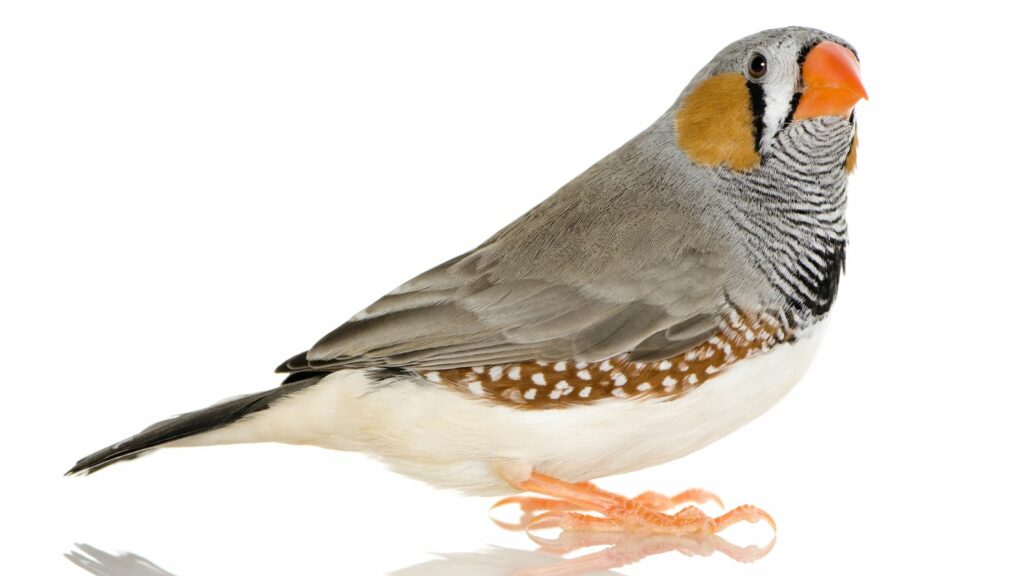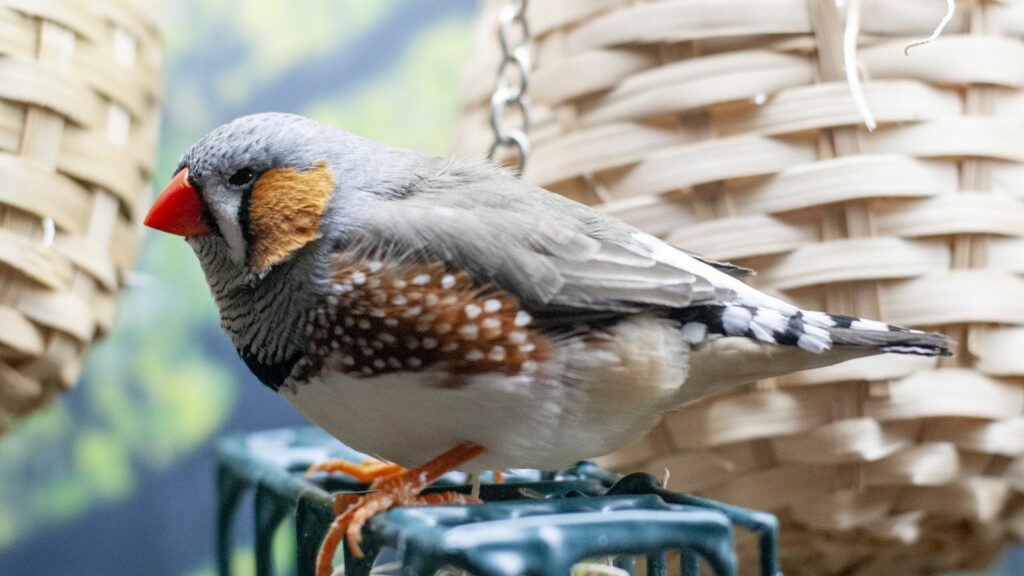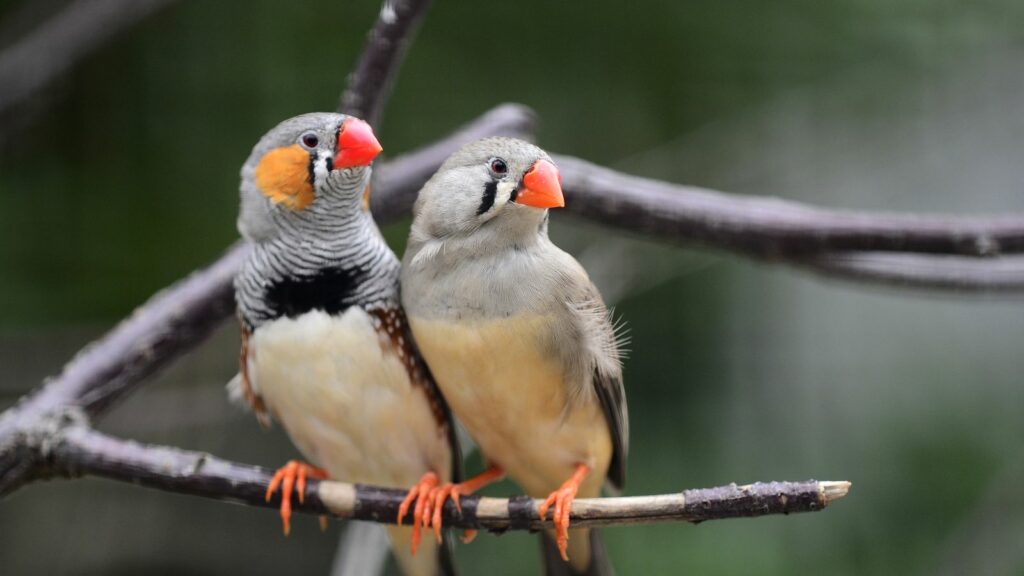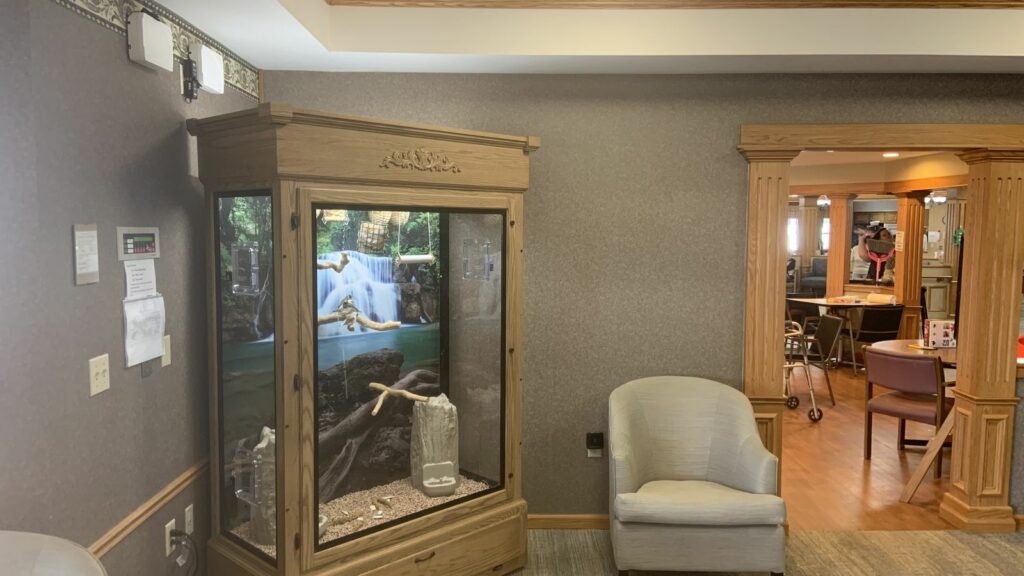Estimated Read Time: 6 minutes
The Zebra Finch
Welcome to Part 8 of The Finches of Serenity!
This blog series is all about the amazing finches that call our Serenity Aviaries, home.
Today, we’re diving into information about the colorful and wildly popular Zebra Finch!

Other Common Names
- Chestnut-eared Finch
- Spotted-sided Finch
Natural Habitat

The zebra finch is native to arid regions throughout Australia.
They’re found mainly in the center of the continent, usually in large flocks. You can also find them in dry regions in Indonesia and East Timor.
In their habitats, zebra finches prefer to feed on a variety of plant seeds and grasses.
In the seasons where seeds aren’t readily available, they will eat insects, berries, fruits, and other forms of vegetation.
Physical Characteristics

Zebra finches grow to about 4 inches from beak to tail, which is a common length among finches.
The common male’s colors consist of a white belly, grey on its back, a black and white barred tail, bright red beak, dark brown eyes with black teardrops, red/orange patches on its cheeks, and zebra-like stripes on its neck and chest.
A female zebra finch has a slightly duller color scheme.
Its main colors are a pale orange beak, dark brown eyes with a black teardrop, grey/creme back and chest, and a white belly.
Only the males have the ‘zebra stripes’ on their chest and the bright red/orange cheek patches.
The Zebra Finch Bird Song
The male zebra finch has a lot of personality and does most of the singing, while females’ ‘songs’ are more like quick chirps.
Ever heard a zebra finch sing before? Play the video below and listen to the delightful melody.
Play the video to hear this bird’s wonderful song, a song that enchants those in the facilities we service.
Behavior and Temperament

Zebra finches have bubbly personalities, but they aren’t very receptive to being handled by humans.
They may get scared of us if we approach them too aggressively, so we’re very careful when making bird cage cleaning visits.
Although they may not love humans, they’re very social with other zebra finches.
In their natural habitat, these finches travel in large flocks of around 20 in search of food and water.
Breeding Habits of Zebra Finches

Zebra finches don’t follow a specific breeding schedule.
If certain conditions are met, they can breed any time of year after a period of heavy rainfall.
They’re also monogamous, so they’ll find one mate and breed for life.
The Breeding Process
A hen will lay anywhere between four and six eggs per clutch, then she and the male will help incubate the eggs for roughly two weeks.
About five weeks after hatching, fledgling zebra finches become mostly independent.
After around one to two months, we displace the growing fledglings to a new cage so the parent finches can breed once more.
If the parents decide to mate again, they tend to be territorial and aggressive toward their growing fledglings.
So, for the sake of the birds, we safely remove them and place them in a different aviary.
Tips for Designing a Zebra Finch Enclosure

1) Size
We make sure our enclosures are large enough for zebra finches to roam comfortably.
Zebra finches like racing one another from branch to branch around their aviary. They’ll also want to establish their own territory, and a crowded cage won’t allow that.
If they feel crowded, zebra finches may experience stress, aggression, and could even get sick.
2) Shape
Because they enjoy flying back and forth, the length of their enclosure is more important than the height.
Also, avoid using rounded edges for the structure, as this removes some of their available space.
3) Materials
Chewing and ingesting materials can be an issue for finches in an aviary.
The structure should be free of softwood, paint, untreated steel, and soft plastics.
By using high-grade materials, like solid oak, stainless steel wire, and high-grade laminate panels, Serenity Aviaries don’t allow for chewing or ingestion.
4) Features and Accessories
You need food and water access, ventilation, adequate internal temperature, and lighting for a comfortable zebra finch.
Other accessories like nests, swings, and branches are also needed for their rest and stimulation.
NOTE: Finches feel safer when they’re higher up, especially in an aviary. We position their nests, branches, and swings as high up as possible.
Looking for Your Hassle-Free Aviary?

At Serenity, we handcraft spacious aviaries for business facilities in the US.
We also include the birds, feeders, decor, and provide routine services!
The Services We Provide:
- Remove and replace bedding.
- Clean droppings tray.
- Wipe down all surfaces.
- Scrub all cracks and crevices.
- Sanitize and rotate accessories.
- Sanitize and replenish the Infinity Feeder.
- Thoroughly rinse and dry the enclosure.
Next Up: The Parrot Finch!
Thank you for visiting our blog! We will continue our finch-focused blog series on Tuesday, September 26th, 2023, so check back in to learn about the Parrot Finch!
Also, keep an eye out for our other informative blog posts on birds, aviaries, fish, and aquariums!
